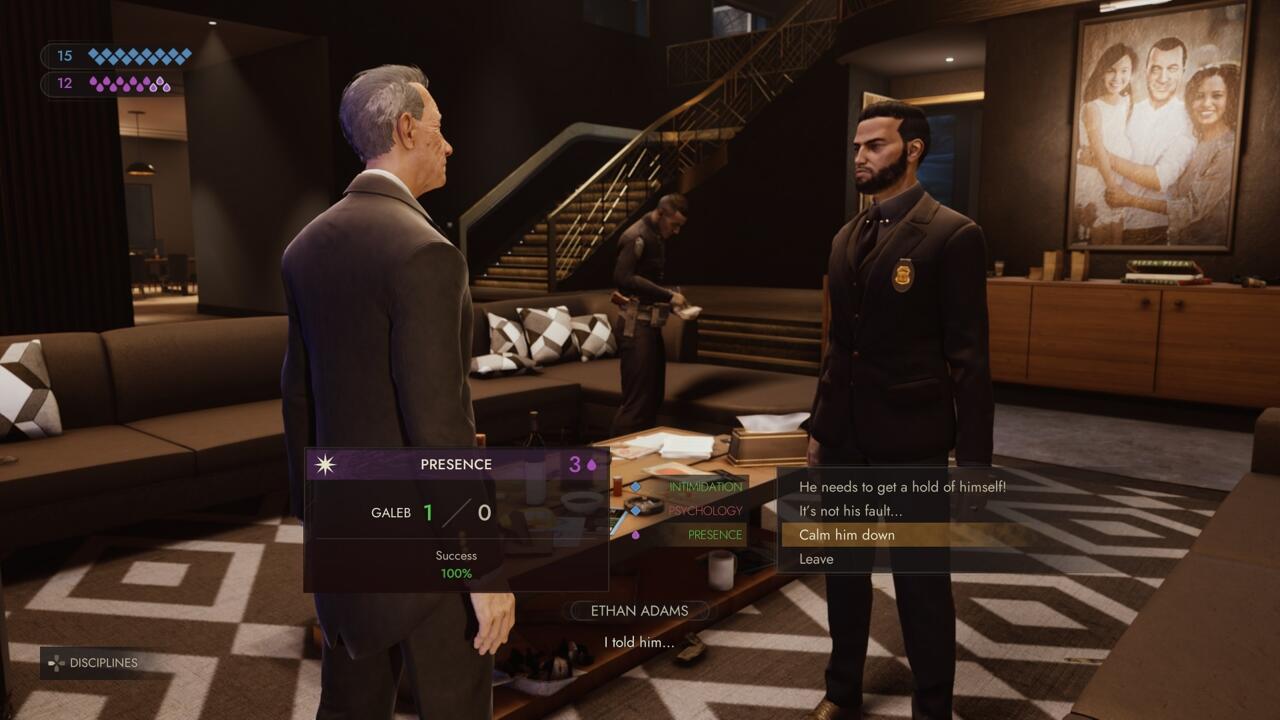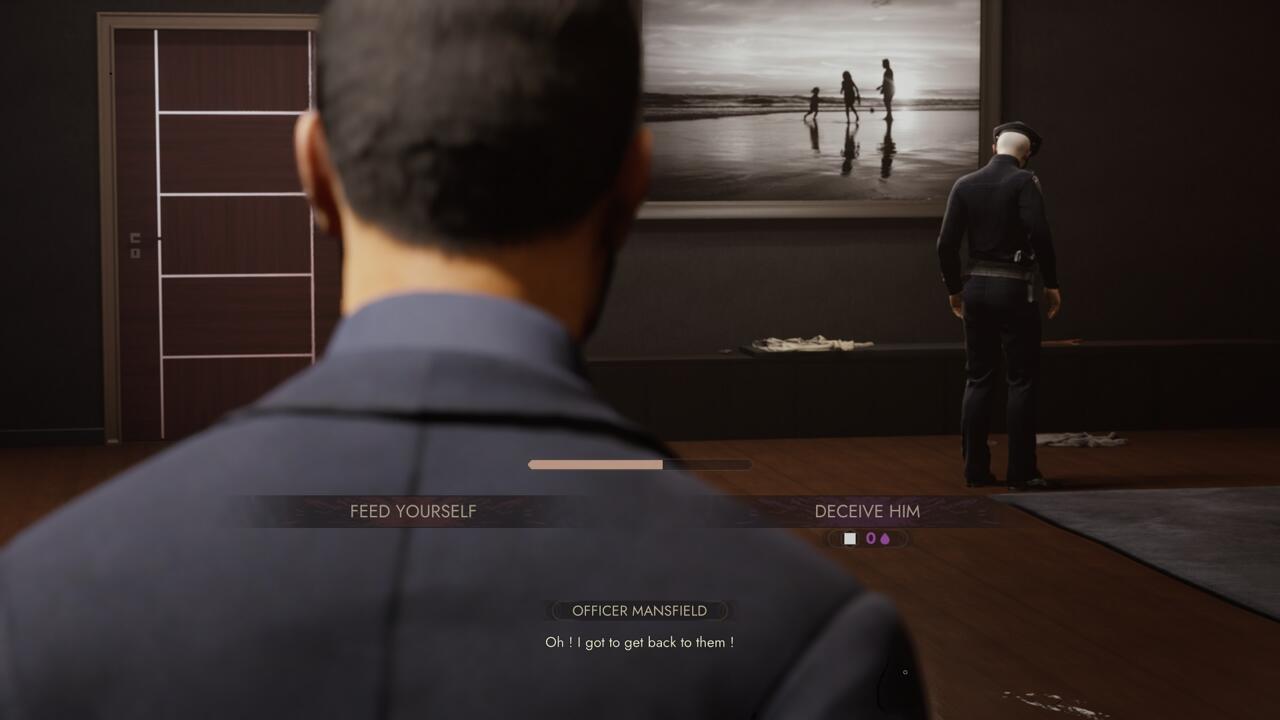Video games love the idea of being a detective. Plenty of games put you into the role of someone trying to solve a mystery, asking you to gather clues and scour scenes for evidence. Often, games have to throw in some contrivances to help you actually spot the important items laying in a scene or to follow trails of blood through an environment, and many attempts fall flat because they’re either too convoluted or include too much handholding. You either feel like Scooby-Doo, still confused as Velma reveals that the ghost haunting the carnival was its greedy owner all along, or like Hercule Poirot, vastly overqualified for the minor mystery before you.
After playing vampire detective in Vampire: The Masquerade – Swansong, it feels like developer Big Bad Wolf Studio has found the right balance between laying out a complex mystery before you and helping you make the Charlie Day-style string board needed to solve it.
Swansong is set in the World of Darkness, the same universe as the upcoming Vampire: The Masquerade – Bloodlines and Bloodlines 2, but focuses on narrative and takes more of its inspiration from the tabletop RPG franchise than the action-RPG approach of Bloodlines. You’ll play as three different vampires in Swansong–each is part of the hidden vampire society in Boston, all playing different roles in the story. The choices you make, characters you interact with, and successes and failures you rack up all affect how the story will shake out. The section I played took place early in the story, in which a vampire named Galeb is dispatched to investigate the murder of a specialty banker for high-end clients.
The victim, Jason Moore, was a human who worked for powerful figures in the local vampire society. As Galeb, you’re there serving two agendas: first, to find out what happened to Moore, and second, to locate five of Moore’s files about his powerful vampire clients, along with anything else that might be suspicious, in order to keep it all from falling into human hands.
The level starts at the entrance of Moore’s penthouse apartment with Galeb having intercepted an FBI agent and then–seemingly after draining and disposing of their body–impersonating them. As you enter the apartment, you’re immediately greeted with a grisly sight: the murder victim, decapitated. A quick conversation with the officer in charge gives you a sense of what’s going on. Moore was seen leaving the apartment with his bodyguards in the middle of the night, and then returning later, seemingly propped between his guards. The bodyguards are missing along with Moore’s head. Figuring out anything beyond that, however, is up to you.
In terms of gathering physical evidence, Swansong feels similar to something like LA Noire, where you can interact with marked items and hotspots that give you information. What makes Swansong work, however, is that the connections are yours to create. There’s no notebook or menu where all the clues you find are stored, so it pays to be observant–and even to take your own notes, as was recommended during our playthrough. Following that advice, I was able to really appreciate how well Big Bad Wolf had put together the scene; information like the times when officers arrived, what they noticed and where they said they saw it, allowed me to pick up on inconsistencies that could point me toward other clues.
While you’ll do your fair share of murder along the way, it’s not a game about tearing out throats and turning into a bat to vanish into the night. Rather, at least in the scene we played, you’re using your vampire powers to blend into human society and manipulate people into getting what you want. Some of what you can uncover, from either people or the environment, is determined by how you choose to invest points in your vampire’s character sheet, much like in a TTRPG.
Investing points into various skills, like Psychology, can help you see through people in a conversation, while Deduction might allow you to make certain connections that prompt additional dialogue or investigation options. You can’t invest in everything, which means you’ll need to choose whether you want to specialize in things like Persuasion or Intimidation, Deduction or Education, and so on.
But while investing in the right areas might get you through some problems, a lot of the Swansong experience is about following clues and leads yourself. Though the scene starts with finding a body, you might notice a blood trail that moves through the apartment. Follow it, and it’ll lead you to the upstairs bedroom and its bathroom, where you discover even more clues. The trail indicates that Moore was injured during his time away from the apartment, and in the bathroom, you discover he treated his wounds–so he was already hurt, and then was murdered soon after. You also find a bag packed with clothes on the bed, along with one of the files you’re searching for–curiouser and curiouser.
Near all that stuff, you might come across Moore’s cell phone, but find yourself locked out of it with a keycode. Investing in the Technology skill would help in this case, but if you pay attention, you can also reason out how to unlock the phone. A drawing made by Moore’s daughter, who loves playing games on his phone, gives a hint at the pattern to unlock it. Later, if you can track down the girl’s birthday somewhere in the apartment, you can work out that it’s also the keypad combination to Moore’s hidden safe. And documents from a security company, along with the testimony of the apartment building’s caretaker, suggest there might be more hidden behind the walls somewhere in the apartment.
Being observant is a major part of Swansong’s gameplay, but the fun part of being a vampire is having the unholy edge of supernatural powers. In the scene we played, these came into play mostly in conversations, where you’re often not just exhausting a list of questions, you actually need to push people into giving you information or cooperating with you–either through persuasion, coercion, or straight-up vampiric mind control. The powers you have at your disposal are also determined by points you allocate on your character sheet and how you level up your vampires, and they come up contextually when you’re dealing with people.
These abilities come to the forefront in Swansong’s take on combat: verbal sparring. Occasionally, you’ll meet a character who doesn’t just tell you what you want to know or require light prodding through dialogue options and vampiric skills. These moments are called Confrontations, and require you to pay attention to the other person to reason out how you can best get your way–whether through specific dialogue choices that will convince them, using your skills like intimidation, or leveraging your monstrous capabilities. The scene we played included a couple of these moments, like one in which you discover the parking attendant of Moore’s apartment building is also a low-level vampire. After following a blood trail to the apartment’s garbage chute, you discover the parking attendant is the only one with a key, and he’s unwilling to part with it, for…reasons.
Forcing your vampiric will on people takes its toll, however, and this is where Swansong got really interesting. Zonking a strong-willed police officer into handing over a key or forgetting he saw you sneak into an off-limits area drives up your vampiric hunger, which is tracked on a gauge at the top of the screen. The hungrier you are, in effect, the weaker you are; using your powers will fill portions of your hunger meter, and if you don’t have enough of the meter left empty, those powers will be off-limits to you. Managing that meter, as well as the Willpower meter that governs your ability to use skills, means finding victims and feeding.
But Swansong is a game about being a vampire and not getting noticed, so you can’t just start snacking on people. You first need to find out-of-the-way places where you’ll be alone with a victim, and then need to lure that victim into that room. Feeding is also more art than science, with a meter appearing on the screen that dictates how much blood you draw from your victim and how much it restores your abilities. The meter fills very quickly as you start to drink, and tapping a button stops it, so if you time it well, you’ll get what you need while leaving your victim alive. Time it poorly and you might not drink enough blood before releasing your victim–or you might go too far and kill them. Then again, you can always just drink your fill and then stuff the body in a closet, the caveat of this approach is that those bodies will eventually be discovered. That won’t mean you’ll suddenly have cops descending on you like Solid Snake on Shadow Moses Island, but it can affect the overall story, and since one of your goals is to help vampire society remain secret, that can be a problem.
Managing your hunger is an important part of the game, as the end of the scene made very clear. Keeping your hunger down and Willpower up are important because you never know when you might need your powers in a conversation, and major story beats can hinge not only on what choices you’ve made and whether you’ve succeeded or failed at your goals, but on how much access to your powers you have.
At the end of the investigation, leaving Moore’s apartment required blowing Galeb’s cover with the cops. That might not be a big deal under normal circumstances, but the sheer number of police made it a dicey prospect. The final moments of the demo played out as a cutscene, giving you chances to quickly decide how to respond to various situations. Passing each of the cops on his way out, you could choose for Galeb either to cloud their minds with his vampiric powers–allowing him to slip out stealthily, but increasing his hunger–or straight-up murder them.
Things were going fine in this final scene as I used vampiric mind control to zonk out one cop, then two, but I realized quickly that even the small amount of hunger I’d built up previously in the scene would be my undoing. Spotted by a third police officer, I couldn’t muster the power to dissuade him, leaving me with no option but to tear his throat out. Instantly, the scene changed to chaos, as the 15 or so fully alerted police descended on me. Galeb managed to slice his way out of the situation, but it meant murdering everyone–not exactly the best outcome. I’d been sent to Moore’s apartment to decrease suspicion against vampires, but circumstances and poor planning had conspired to cause me to leave everything in worse shape.
Coupled with a relatively hands-off approach to its investigation and conversation mechanics that require you to pay attention and make use of the information you discover, Swansong’s approach to your vampiric powers seems like it’ll create a lot of situations in which you’ll have to live with the consequences of your actions. Even over just two hours, it made for an engaging and unfolding story, one that felt pretty responsive to player actions. Most interesting, though, was how much it felt like I was really figuring out a mystery, rather than just ticking off items on a checklist to push the story forward. In fact, it’s fully possible to not solve the mystery of Moore’s death, it seems, and the game’s willingness to support both success and failure helps sell the sense of actually being a detective–albeit one that’s a creature of the night.
- Coinsmart. Europe’s Best Bitcoin and Crypto Exchange.
- Platoblockchain. Web3 Metaverse Intelligence. Knowledge Amplified. FREE ACCESS.
- CryptoHawk. Altcoin Radar. Free Trial.
- Source: https://www.gamespot.com/articles/vampire-the-masquerade-swansong-hands-on-preview-det-acula/1100-6501936/?ftag=CAD-01-10abi2f
- abilities
- About
- access
- across
- Additional
- advice
- All
- AREA
- Art
- BAT
- before
- BEST
- blood
- board
- body
- boston
- Building
- capabilities
- carnival
- case
- Cause
- chances
- characters
- charge
- clients
- Cloud
- company
- Connections
- consequences
- Conversation
- conversations
- cops
- could
- Couple
- create
- deal
- dealing
- Demo
- Developer
- different
- discover
- discovered
- documents
- down
- Drink
- During
- Early
- Edge
- Education
- Entrance
- Environment
- experience
- Failure
- fair
- fbi
- fine
- First
- focuses
- follow
- Forward
- Franchise
- fun
- game
- gameplay
- Games
- Ghost
- Giving
- Goals
- having
- head
- hidden
- Hinge
- How
- How To
- HTTPS
- human
- i
- idea
- important
- Included
- increasing
- information
- Inspiration
- invest
- investigate
- investigation
- investing
- IT
- keeping
- Key
- LA
- large
- lead
- Level
- light
- List
- local
- love
- major
- MAKES
- managing
- masquerade
- Mechanics
- more
- Mystery
- normal
- Officer
- Option
- Options
- order
- Other
- owner
- parking
- Pattern
- Pay
- People
- physical
- planning
- play
- player
- Playing
- playing games
- Plenty
- Point
- Police
- poor
- possible
- power
- powerful
- Preview
- Psychology
- RE
- reasons
- recommended
- room
- s
- safe
- Said
- Science
- Screen
- security
- sell
- sense
- serving
- set
- Shadow
- Share
- skills
- small
- sneak
- So
- Society
- SOLVE
- Soon
- Spot
- start
- Story
- studio
- success
- supernatural
- support
- Technology
- The
- the world
- Throat
- Through
- time
- together
- top
- track
- uncover
- unlock
- What
- WHO
- Wolf
- Work
- work out
- worked
- world
- yourself














